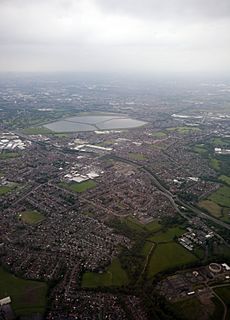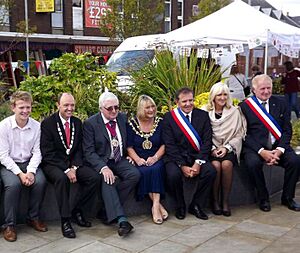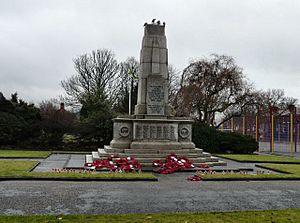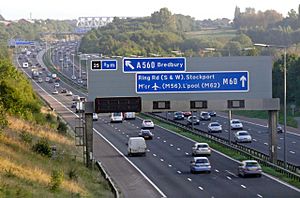Denton, Greater Manchester facts for kids
Quick facts for kids Denton |
|
|---|---|
 Denton Town Hall |
|
| Population | 36,591 (2011) |
| OS grid reference | SJ925954 |
| • London | 202.4 mi |
| Metropolitan borough | |
| Metropolitan county | |
| Region | |
| Country | England |
| Sovereign state | United Kingdom |
| Post town | MANCHESTER |
| Postcode district | M34 |
| Dialling code | 0161 |
| Police | Greater Manchester |
| Fire | Greater Manchester |
| Ambulance | North West |
| EU Parliament | North West England |
| UK Parliament |
|
Denton is a town in Tameside, Greater Manchester, England. It is about five miles (8 km) east of Manchester city centre. Long ago, it was part of Lancashire. In 2011, about 36,591 people lived there.
Contents
Denton's Story: A Look Back in Time
What Does the Name Denton Mean?
The name Denton probably comes from "Dane-town." This idea is supported by other local names like Danehead-bank. The word 'Dane' comes from an old Anglo-Saxon word meaning 'valley'. So, Denton literally means "valley town."
Ancient Times in Denton
A very old coin from the 6th or 7th century was found in Danesheadbank. It was part of a group of old coins found in Denton. A long earth wall called Nico Ditch also runs through Denton. It was likely a border in the 8th or 9th centuries. You can still see about 300 meters of it on Denton golf course. It is about 4 meters wide and 1.5 meters deep.
Denton in the Middle Ages
In the early 1200s, Denton was part of the Manor of Withington. A manor was a large estate owned by a lord. This estate included other nearby areas like Didsbury and Haughton. Powerful families like the Hathersages and Tattons ruled these lands.
The Hat-Making Industry
Hat making started in Denton as early as 1702. By the late 1800s, Denton was a leader in making felt hats. In 1800, there were only 4 hat factories. By 1825, there were 25, making Denton a major hat-making center. About 24,000 felt hats were made in Denton each week by 1840. The town grew a lot because of this success.
The hat industry faced tough times in the 1840s. Wages dropped, and many factories closed. This was partly because silk hats became more popular. But in the 1850s, felt hats became popular again. New machines also helped reduce costs. By the early 1900s, Denton was the biggest felt hat-making center in Britain. In 1907, most of the 16 million felt hats made in England came from Denton and Stockport. By 1921, about 41% of Denton's workers were in the hat industry. The last hat factory in Denton closed in 1980.
Working in hat factories could be dangerous. Workers often touched mercury, which was used to prepare fur. This could cause mercury poisoning. Poor air flow also caused problems. In 1901, an explosion at a factory killed 13 people. It was caused by fumes from chemicals used for dyeing.
Many types of hats were made in Denton. These included felt hats, silk hats, and the common cloth cap. In the 1930s, the "Attaboy" trilby hat became very famous. It was made by the Denton Hat Company. Hats were made for people in Britain and for export to other countries. The saying "If you want to get ahead, get a hat" started in Denton. People even believed that if you didn't wear a hat, you wouldn't get a job! The phrase "mad as a hatter" also came from Denton. This was because mercury poisoning could make hat makers act strangely.
In 2003, the old Wilson's Hat Factory was taken down. Other factories and old houses were also removed. A new shopping area called 'Crown Point North' was built there.
Coal Mining in Denton
Denton is located on a coalfield and used to have many coal mines. These included Denton Colliery, Top Pit, and Hulmes Pit. The coal dug up was used by local factories that ran on steam power.
Denton Colliery was the largest mine. It eventually took over the other local pits. It even used some old shafts for air or to pump water out. A special railway line connected Denton Colliery to the main railway. This line used steam engines, not horses.
In 1926, miners at Denton Colliery joined a national strike. They were protesting lower pay and longer hours. This led to the General Strike. When the General Strike ended, coal miners kept striking for months.
Miners at Denton Colliery stayed on strike until November 1926. This was much longer than other nearby miners. When they returned, they had to work longer hours for the same pay.
Sadly, the mines were not looked after during the strike. Denton Colliery flooded so badly that it could no longer be used. The company closed in 1929. The mine's tall structure was taken down in 1932. The shaft was finally filled in 1974.
You can still find some signs of the old colliery. The old offices are now a stonemason's shop. A small part of the colliery wall is behind it. Across the road, a building that was once a mine rescue station is now two houses. Two old miner's cottages are now one house. You can also see parts of the old railway line and a canal that was never finished.
Oldham Batteries: A New Industry
After hat making, the most important industry in Denton was making lead-acid batteries. This was done by Oldham Batteries. Joseph Oldham started his engineering shop in 1865. By 1887, his company made machines for hat making. They also started making equipment for coal mining, like portable lamps for miners. These new battery-powered lamps eventually replaced the older safety lamps.
In 1920, the company began making batteries for cars and trucks. Over time, they also made larger batteries, including those for submarines.
Oldham Batteries became a big employer in Denton, with over 1,000 workers. But in 2002, the factory closed down. The old factory site is now gone. New houses and a wellness center are being built there. The ground needed a lot of cleaning because of lead and other chemicals from the old factory.
How Denton is Governed
Local History and Councillors
Denton was once a small part of the large parish of Manchester. In 1866, it became its own civil parish. In 1894, the area grew to include Haughton. You can still see Haughton's name in places like Haughton Green. In 1894, Denton became the Denton Urban District.
In 1974, Denton's Urban District was removed. Its area became part of the new Metropolitan Borough of Tameside. This is part of Greater Manchester.
Since 1974, Denton has had three council areas: Denton North East, Denton South, and Denton West. Each area chooses three councillors. These councillors help run the town. The Denton West area has sometimes elected Conservative councillors. However, no Conservative councillor has been elected in Denton since 1987.
Here are the nine councillors for Denton after the May 2022 elections:
| Denton North East | Denton South | Denton West | |
|---|---|---|---|
| Vincent Ricci | Jack Naylor | Mike Smith | |
| Allison Gwynne | Claire Reid | Brenda Warrington | |
| Denise Ward | George Newton | George Jones | |
Since 1998, local groups called District Assemblies have been set up. These groups include councillors and local advisors. They help manage local services like parks, road repairs, and community events. The Denton and Audenshaw District Assembly manages a budget of over £1.5 million each year. The old council room in Denton Town Hall was updated in 2000 for these meetings.
Town Twinning: Friends Across Borders
On December 5, 1992, Denton became a twin-town with Montigny-le-Bretonneux, a town near Paris, France. There is a "French road sign" outside Denton Town Hall. It shows how far it is to Montigny. A similar "English road sign" is outside Montigny's Town Hall pointing to Denton. Denton celebrated 20 years of twinning in 2012.
For a while, the French sign in Denton pointed the wrong way! But in 2007, it was fixed to point south.
Since September 2012, Denton has also been twinned with Kierspe in Germany. Kierspe is near Cologne and has been twinned with Montigny for 25 years.
There is also a sign for Kierspe on the town hall. It also points south, which is not the correct direction for Germany.
Volunteers run the town twinning program. They raise money and get donations to help build friendships. They also create educational and cultural links between Denton and its twin towns.
Who Represents Denton in Parliament?
Denton is part of the Denton and Reddish parliamentary constituency. A Member of Parliament (MP) represents this area in the UK Parliament. The current MP for Denton is Andrew Gwynne. He was first elected in 2005.
Here are the Members of Parliament who have represented Denton since 1885:
| Election | Member | Party | Parliamentary constituency | |
|---|---|---|---|---|
| 1885 | Richard Peacock | Liberal | S.E. Lancs., Gorton Division | |
| 1889 by-election | Sir William Mather | Liberal | S.E. Lancs., Gorton Division | |
| 1895 | Ernest Frederic George Hatch | Conservative | S.E. Lancs., Gorton Division | |
| 1904 | Liberal | S.E. Lancs., Gorton Division | ||
| 1906 | John Hodge | Labour | S.E. Lancs., Gorton Division | |
| 1918 | Austin Hopkinson | Coalition Liberal | Lancs., Mossley Division | |
| 1922 | Independent | Lancs., Mossley Division | ||
| 1929 | Herbert Gibson | Labour | Lancs., Mossley Division | |
| 1931 | Austin Hopkinson | National Independent | Lancs., Mossley Division | |
| 1945 | Rev. George Savile Woods | Labour Co-op | Lancs., Mossley Division | |
| 1950 | Rev. George Savile Woods | Labour Co-op | Droylsden Borough | |
| 1951 | William Richard Williams | Labour | Droylsden Borough | |
| 1955 | Konni Zilliacus | Labour | Manchester, Gorton Borough | |
| 1967 by-election | Kenneth Marks | Labour | Manchester, Gorton Borough | |
| 1983 | Andrew Bennett | Labour | Denton and Reddish Borough | |
| 2005 | Andrew Gwynne | Labour | Denton and Reddish Borough | |
Important Places in Denton
Denton has a main war memorial, or cenotaph, in Victoria Park. This memorial remembers people from Denton and Haughton who served in the two World Wars. Their names were given by their families. The memorial was revealed on July 23, 1921. About 3,500 men from Denton fought in World War I, and 369 of them died.
The oldest church in Denton is St. Lawrence's. It is almost 500 years old, built in 1531. It is a very important Grade II* listed building. People sometimes call it "Th'owd Peg" (the old peg). This is because it was built with wooden pegs instead of nails. It is also known as the black and white church because of how it looks. There is a local story that a pirate is buried there. This is because of a gravestone with a skull and crossbones. But it was actually a special gravestone for a soldier named Samuel Bromley.
The beautiful Victorian St Anne's Church, Haughton, is also a very important building. It is built in the Gothic Revival style.
Getting Around Denton: Transport
Denton has a train station called Denton railway station. However, only two passenger trains run each week, on Saturday mornings. These are called Parliamentary trains. The line is mostly used by freight trains and special charter trains.
Bus services in Denton are run by Stagecoach Manchester. You can take buses to places like Hattersley, Manchester city centre, Stockport, and Ashton-under-Lyne. Some local bus routes include:
- 201: Hattersley to Manchester city centre, through Hyde and Denton.
- 202: Gee Cross to Manchester city centre, through Hyde and Denton.
- 322: Haughton Green to Stockport, through Denton.
- 335: Ashton-under-Lyne to Denton, through Dukinfield.
The M67 Denton Relief Road motorway was built between 1978 and 1981. It runs east to west through Denton. It was originally planned to be part of a motorway from Manchester to Sheffield. At Denton Island, the M67 connects with the M60 Manchester Ring Road.
Schools in Denton
Denton has several primary and secondary schools.
Primary Schools
- Corrie Primary and Nursery School
- Denton West End Primary School
- Greswell Primary School
- Linden Road Primary School
- Manor Green Primary and Nursery School
- Russell Scott Primary School
- St Anne's Primary School
- St John Fisher RC Primary School
- St Mary's RC Primary School
Secondary Schools
- Denton Community College
- St Thomas More RC College
Sports in Denton
Cricket
Denton has three semi-professional cricket clubs. They all play in the Greater Manchester Cricket League.
Denton CC plays at Egerton Street. They won the league in 1994 and 1995. Famous players like Malcolm Marshall have played for them.
Denton West CC plays at Windsor Park. They were league champions many times, including in 1996, 1997, and 2013.
Denton St Lawrence CC plays at Sycamore Park. They won the Walkden Cup in 2005.
Football
Denton Town FC plays in the Cheshire Football League Division One. The club started in 1920 as Bradford Parish. They moved and changed their name in the 1990s. Their home ground is now at Whittles Park Estate.
Famous People from Denton
- Jimmy Armfield, a famous footballer.
- Thomas Bowler and William Bowler, hat makers.
- Mick Hucknall, lead singer of the band Simply Red.
- Geoff Hurst, a footballer who won the 1966 World Cup with England.
- Zach Clough, a professional footballer.
- Paul Lake, played football for Manchester City.
- Alan "Reni" Wren, drummer for The Stone Roses.
- Col Needham, who created the Internet Movie Database (IMDB).
- Jean Stubbs, a British author.
- Colin Haughton, a badminton player.
See also
 In Spanish: Denton (Gran Mánchester) para niños
In Spanish: Denton (Gran Mánchester) para niños






